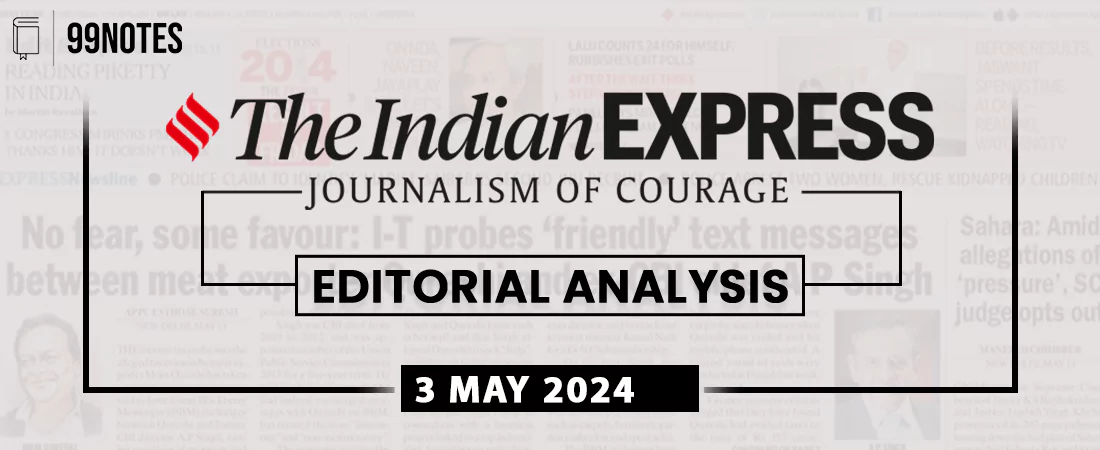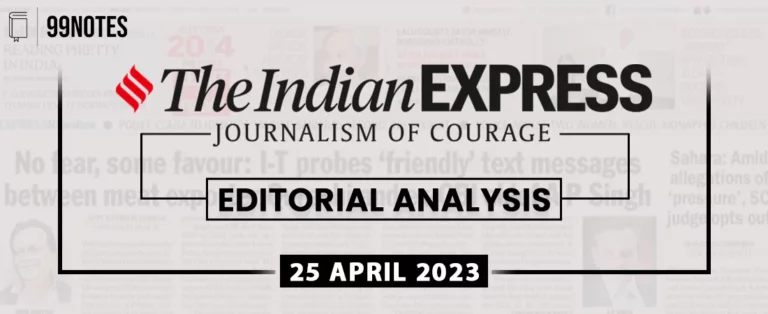3 May April 2024 : Indian Express Editorial Analysis
1. The Vishwa Bandhu
| Topic: GS2 – Governance – Government policies – Interventions for development in various sectors |
| Context: |
|
What is Vision India@2047 ?:
- Vision India@2047 is a project initiated by the NITI Aayog, the apex policy think tank of India, to create a blueprint for India’s development in the next 25 years.
- The project aims to make India a global leader in innovation and technology, a model of human development and social welfare, and a champion of environmental sustainability.
Introduction: The Requirements for Viksit Bharat in the Next 25 Years:
- Viksit Bharat, or developed India, in the forthcoming quarter-century will necessitate a comprehensive strategy encompassing various domains.
- This analysis delves into the key requirements and pathways to achieving this goal, focusing on political stability, foreign policy, economic development, national security, education, and international partnerships.
Political Stability: A Prerequisite for Long-Term Vision:
- Political stability lays the foundation for sustained progress and reform. The Indian electorate’s choices in the coming years will significantly influence the nation’s trajectory.
- Stability enables the conceptualization and implementation of long-term policy prescriptions crucial for Viksit Bharat’s development.
Foreign Policy: Leveraging International Relations for Development:
- An effective foreign policy is pivotal for accessing resources, markets, technologies, and best practices.
- India’s shift towards a “Bharat First” approach since 2014 underscores a focused foreign policy agenda aimed at maximizing partnerships while safeguarding national interests.
- The concept of Vishwa Bandhu Bharat emphasizes India’s assertiveness on the global stage, necessitating multi-vector diplomacy and deepening international engagements.
Economic Development: Manufacturing and Technology as Pillars:
- The expansion of manufacturing, especially in critical and emerging technologies, forms the bedrock of India’s economic strength.
- To leapfrog past previous neglect, India must prioritize strong international collaborations to acquire technological expertise.
- The “Make in India” initiative assumes significance not only for economic growth but also for national security, particularly in challenging domains like defence.
Education and Skill Development: Harnessing Demographic Dividend:
- India’s demographic dividend presents immense opportunities, particularly in professions aligned with global demands.
- Expanding education and training capacities is essential to capitalize on these prospects.
- However, partnerships must align with Indian values and ensure the security of its citizens, both domestically and internationally.
International Partnerships: Strengthening Connectivity and Security:
- India’s engagement with international partners is crucial for enhancing connectivity and security.
- Initiatives like the IMEC corridor and the INSTC facilitate economic integration and security cooperation across regions.
- India’s active participation in various forums, such as BRICS and East Asia Summit, underscores its commitment to maintaining political balances amidst global transformations.
Conclusion:
- The concept of Vishwa Bandhu, encapsulated in Modi Ki Guarantee, encapsulates India’s resolve to navigate the complexities of the evolving global landscape.
- By prioritizing political stability, strategic foreign policy, economic development, education, and international partnerships, India aims to realize the vision of Viksit Bharat in the next 25 years.
| What are the other Aspects of Viksit Bharat? |
|
| Practice Question: India’s aspiration to become a developed nation, termed as “Viksit Bharat,” within the next 25 years necessitates a comprehensive strategy across various domains. Discuss the key requirements and pathways for achieving this goal. (250 words/15 m) |
2. A system that heals
| Topic: GS2 – Governance – Government policies – Interventions for development in various sectors |
| Context: |
|
What is Universal Health Coverage (UHC)?
- UHC is widely discussed worldwide as an essential component of the development agenda.
- The outbreak of Covid-19 has necessitated the need for universal health coverage as the health systems failed miserably across the globe during those times.
- Considering the importance of UHC, the United Nations declared 12th December as International Universal Health Coverage Day (UHC Day) in 2017.
- The United Nations defines UHC as “everyone, everywhere should have access to the health services they need without risk of financial hardship.”
- Sustainable Development Goals target 3.8(“Achieve universal health coverage, including financial risk protection, access to quality essential healthcare services and access to safe, effective, quality and affordable essential medicines and vaccines for all”) also focuses on achieving universal health coverage.
- A big push in the health sector is the need of the hour,in the absence of which the health and wellness centres will end up in deplorable conditions similar to the current primary health centres and sub-centres.
What is National Health Policy 2017?
- Aiming to provide healthcare in an “assured manner” to all, the NHP 2017 strives to address current and emerging challenges arising from the ever-changing socio-economic, technological and epidemiological scenarios.
Features
- The policy advocates a progressively incremental assurance-based approach.
- It denotes an important change towards a comprehensive primary health care package which includes care for major NCDs (non-communicable diseases), mental health, geriatric health care, palliative care and rehabilitative care services.
- It envisages providing larger package of assured comprehensive primary health care through the ‘Health and Wellness Centres’
- The policy proposes free drugs, free diagnostics and free emergency and essential health care services in all public hospitals in a bid to provide access and financial protection.
- It also envisages a three-dimensional integration of AYUSH systems encompassing cross referrals, co-location and integrative practices across systems of medicines.
- It also seeks an effective grievance redressal mechanism.
- Health Expenditure: The policy proposes raising public health expenditure to 2.5% of the GDP by 2025.
Targets:
- To increase life expectancy at birth from 67.5 to 70 by 2025 and reduce infant mortality rate to 28 by 2019.
- To reduce mortality of children under-five years of age to 23 by the year 2025.
- To allocate a major proportion of resources to primary care and intends to ensure availability of two beds per 1,000 population distributed in a manner to enable access within golden hour (the first hour after traumatic injury, when the victim is most likely to benefit from emergency treatment).
Government Health Expenditure: Trends and Commitment:
- The article highlights the government’s commitment to enhancing public expenditure on health, in line with the objectives outlined in the National Health Policy (NHP) 2017.
- Notably, the National Health Accounts (NHA) data reveal a significant increase in government health expenditure (GHE) as a proportion of GDP, marking a 63 percent surge between 2014-15 and 2021-22.
- This rise reflects a concerted effort to achieve universal access to quality and affordable healthcare, as envisaged by the NHP 2017.
Decline in Out-of-Pocket Expenditure: A Positive Trend:
What is Out of Pocket Expenditure (OOPE)?
- OOPE is the money paid directly by households, at the point of receiving health care. This occurs when services are neither provided free of cost through a government health facility, nor is the individual covered under any public or private insurance or social protection scheme.
- One of the notable trends highlighted in the article is the consistent decline in Out-of-Pocket Expenditure (OOPE) as a share of total health expenditure.
- This decline, from 62.6 percent to 39.4 percent between 2014-15 and 2021-22, signifies a significant relief for individuals and families accessing healthcare services.
- The article attributes this positive trend to various factors, including government-funded insurance schemes like the Ayushman Bharat Pradhan Mantri Jan Arogya Yojana (AB-PMJAY) and increased utilization of government healthcare facilities.
Impact of Health Initiatives: Access to Affordable Medicines and Services:
- The article underscores the impact of government health initiatives in reducing OOPE and improving access to affordable healthcare services.
- Initiatives such as free drugs and diagnostics services at government facilities, establishment of Ayushman Arogya Mandirs (Health and Wellness Centres), and Jan Aushadhi Kendras have played a crucial role in alleviating financial burdens on individuals.
- The provision of free medicines, diagnostics, and surgical items has resulted in substantial savings for consumers and contributed to a decline in OOPE.
Social Determinants of Health: Investments Beyond Healthcare Services:
- Beyond healthcare services, the article emphasizes the importance of investments in social determinants of health, such as water supply and sanitation.
- Initiatives like the Jal Jeevan Mission and Swachh Bharat Mission have had significant positive health effects, including reducing mortality rates due to diarrhoea and malnutrition.
- These initiatives reflect a holistic approach to public health, addressing factors that influence health outcomes beyond the healthcare system.
Strengthening Health Infrastructure: Towards Universal Health Coverage:
- Lastly, the article highlights investments in health infrastructure under various schemes, such as the Pradhan Mantri Swasthya Suraksha Yojana and Emergency Response and Health System Preparedness Package.
- These initiatives aim to strengthen the country’s health infrastructure and pave the way for Universal Health Coverage (UHC) in the future.
- Overall, the rising trends in government health expenditure and declining OOPE signify positive strides towards achieving a more progressive and inclusive health system in India.
Conclusion:
- The article underscores the government’s commitment to enhancing public expenditure on health and improving access to affordable healthcare services.
- Through various initiatives and investments, India is moving towards a more inclusive and equitable health system, with a focus on reducing financial barriers and strengthening health infrastructure to achieve Universal Health Coverage.
| What are the Challenges in Implementing UHC in India? |
Inequitable Access to Health Insurance:
|
| PYQ: With reference to the National Rural Health Mission, which of the following are the jobs of ‘ASHA’, a trained community health worker? (2012)
1) Accompanying women to the health facility for antenatal care checkup 2) Using pregnancy test kits for early detection of pregnancy 3) Providing information on nutrition and immunisation. 4) Conducting the delivery of baby Select the correct answer using the codes given below: (a) 1, 2 and 3 only (b) 2 and 4 only (c) 1 and 3 only (d) 1, 2, 3 and 4 Ans: (a) |
| Practice Question: Discuss the significance of the trends in government health expenditure and the decline in Out-of-Pocket Expenditure (OOPE) in India. How do these trends reflect the government’s commitment towards achieving Universal Health Coverage (UHC) and addressing healthcare accessibility? (250 words/15 m) |



